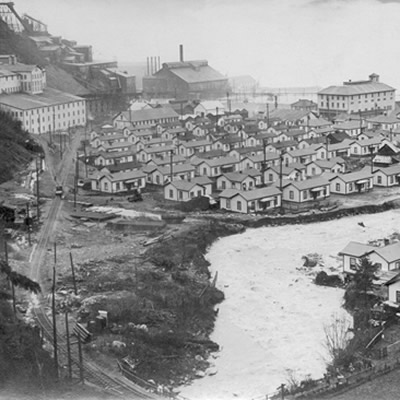Lucky strikes: Early days in British Columbia’s mining industry

The settlement of Britannia Beach, one of two bases for the Britannia Mining and Smelting Company. — Photo: Britannia Mine Museum For more than 180
The settlement of Britannia Beach, one of two bases for the Britannia Mining and Smelting Company. — Photo: Britannia Mine Museum
For more than 180 years, countless discoveries, claims, booms and busts have shaped the mining industry in British Columbia. Here’s a sampling of significant events for four of the province’s top mined resources.
The first mining activity in the province dates back to about 1835. While the Hudson’s Bay Company was busy in the region trading furs, they used coal—brought over by ship from England—for powering steamships, heating buildings and making steel. Then First Nations people pointed out that coal could be found right here, on Suquash Beach on the northern east coast of Vancouver Island.
By 1849, the company had started mining this area, transporting in miners from Scotland and England. However, many of the workers were unimpressed with conditions and went on the first strike in B.C. Others left in hopes of getting rich in the California gold rush. There were also conflicts with the local First Nations people, plus the coal ended up being of poor quality. By 1852, the company had abandoned the Suquash Mine for better ones further south, in Nanaimo.
A few years later, in the 1850s, the miners who had abandoned B.C. for the California gold rush—which by now had fizzled out—had reason to turn back around. The first placer gold was discovered in 1857 along the Fraser River, a few miles upstream from today’s Lytton. When word got out, thousands of people descended on the area, which stretched along the Fraser Canyon from Hope to Lillooet.
Thanks to its newfound population of 16,000, Lillooet became “the largest town north of San Francisco and west of Chicago”—a title that later passed on to B.C. towns like Yale and Barkerville. With so many people now on the mainland, what was once the district of New Caledonia became the Colony of British Columbia.
By 1860, most of the placer gold along the Fraser River was gone. The miners spread out to test their luck in previously undiscovered areas of the province—sparking the next big gold rush, in the Cariboo.
After the Cariboo rush, the next period of frantic mining in the province involved silver, not gold. In 1891, silver-rich galena ore was discovered in the Slocan area of the Selkirk Mountains, and thousands of fortune-seekers swarmed onto these slopes. By the early 1900s, over 300 mines threaded through the mountains, all but one underground. The ore was brought to the surface by rail cars, then carried over steep hillsides in aerial tramways. Two different railways transported the ore away for further processing.
In the heart of the action, the city of Sandon boomed. It had over 5,000 residents, and amenities like a bowling alley, opera house and red-light district. Unfortunately, falling metal prices soon put a stop to its prosperity. By the 1920s, Sandon was on its way to becoming the ghost town it is today, and was destroyed even further by a massive flood in 1955.
Although it wasn’t the first place copper was mined in the province, Britannia Mountain, north of Vancouver, eventually became the biggest. In 1888, a huge find was discovered there. In 1904, the new Britannia Mining and Smelting Company shipped its first ore for smelting. The two world wars really increased output, as copper was needed in great quantities for items like ammunition and weapons. At its peak in the late 1920s and early 1930s, the mine employed 1,100 workers and was the largest producer of copper in the British Commonwealth.
But challenges awaited. The mine had already survived a deadly rock slide, a flu pandemic, a fire and a flood. When copper prices fell, it was forced to close temporarily in 1958. It soon reopened, but times remained tough. In 1974, unable to make a profit, the 70-year-old mine closed for good.




